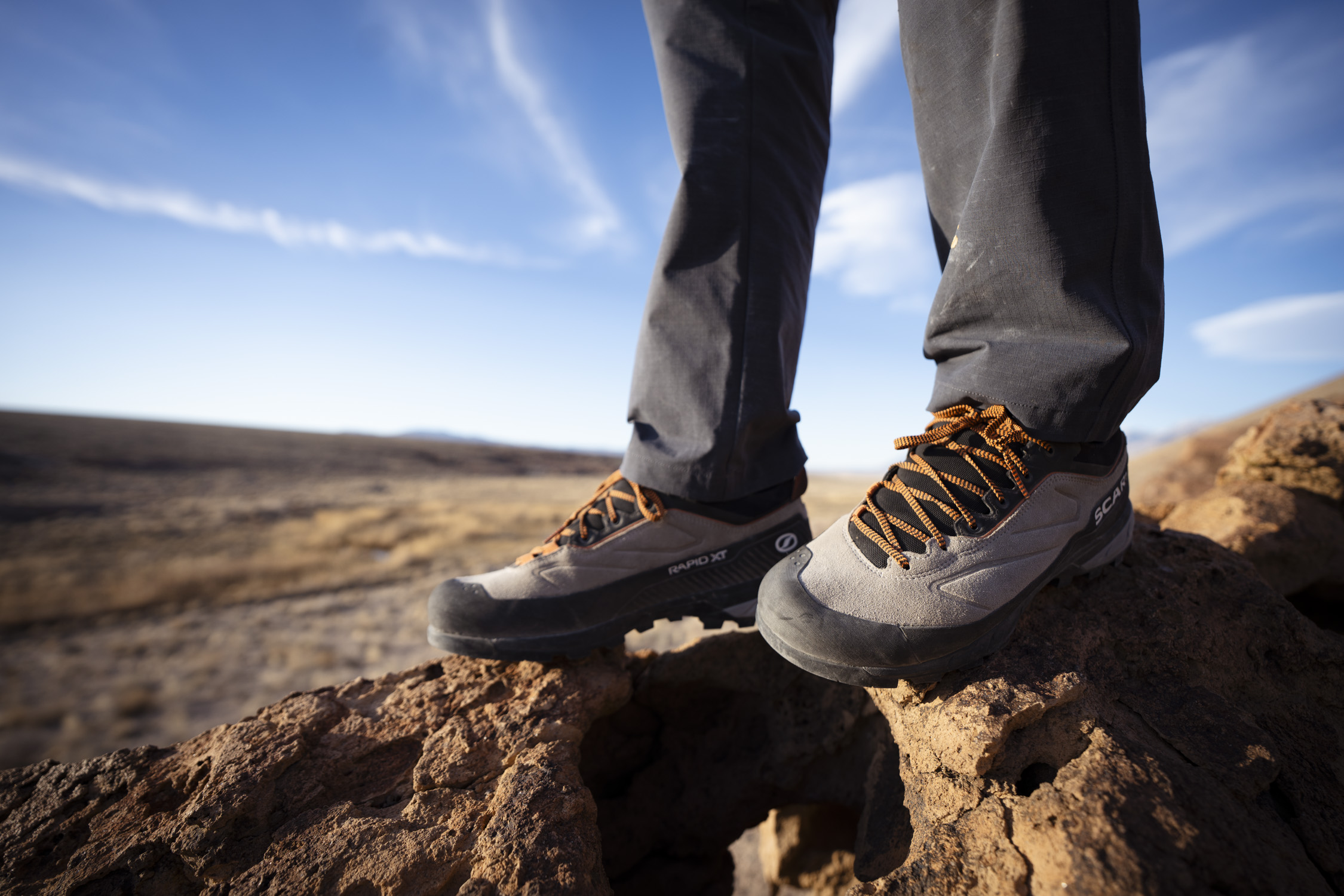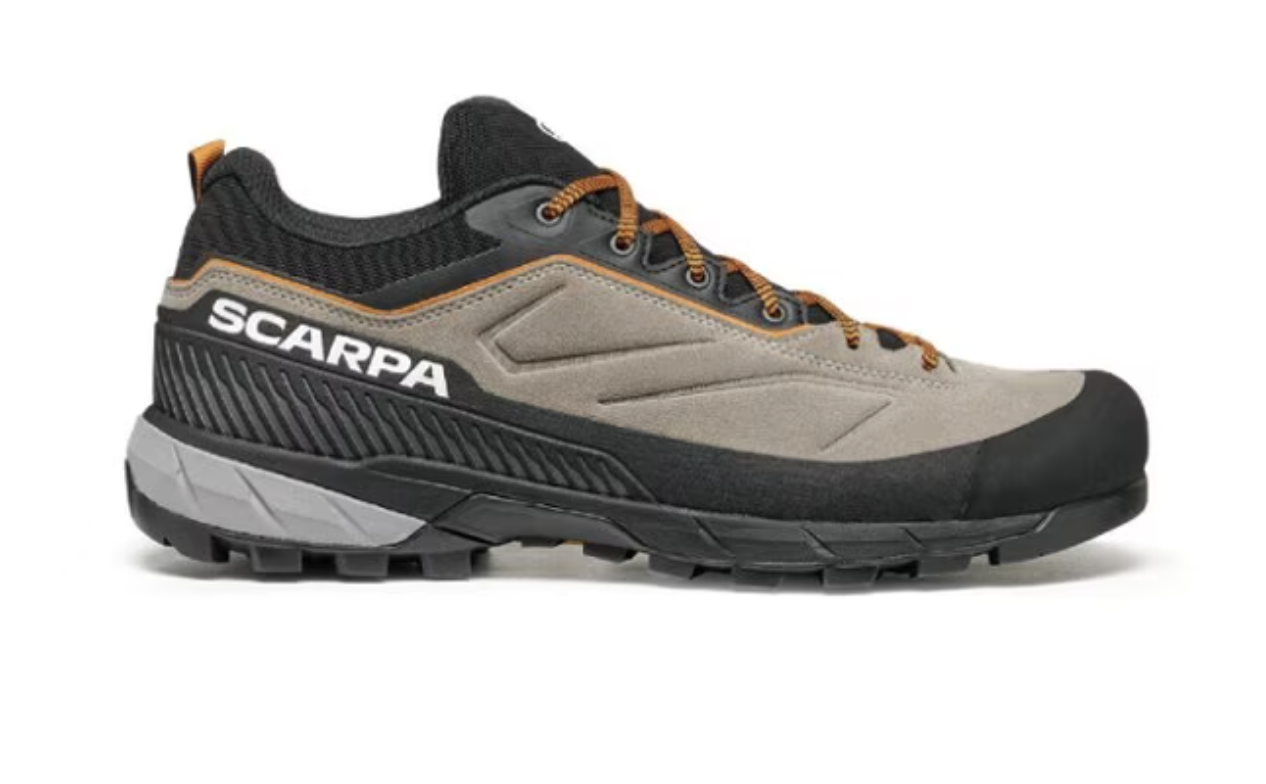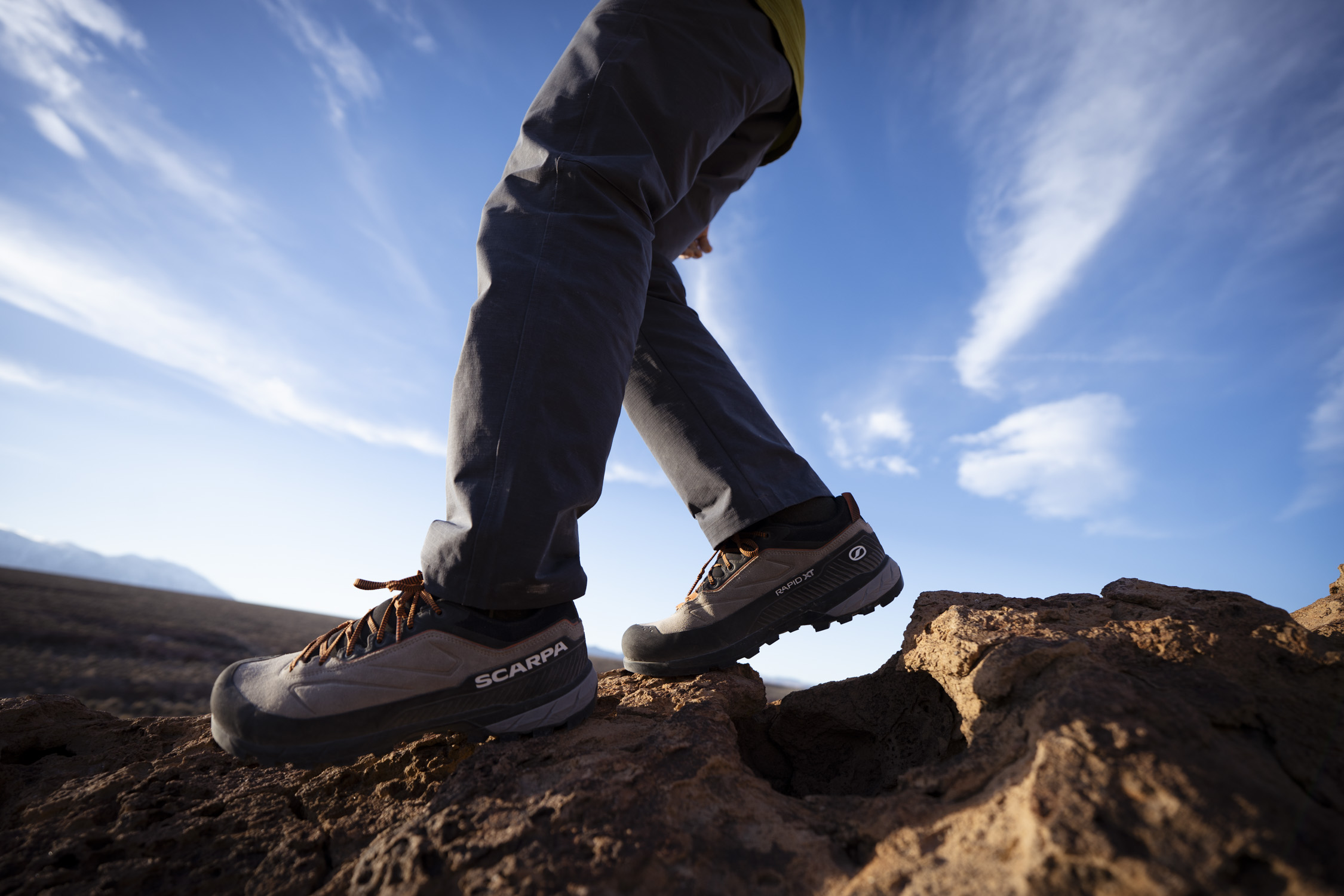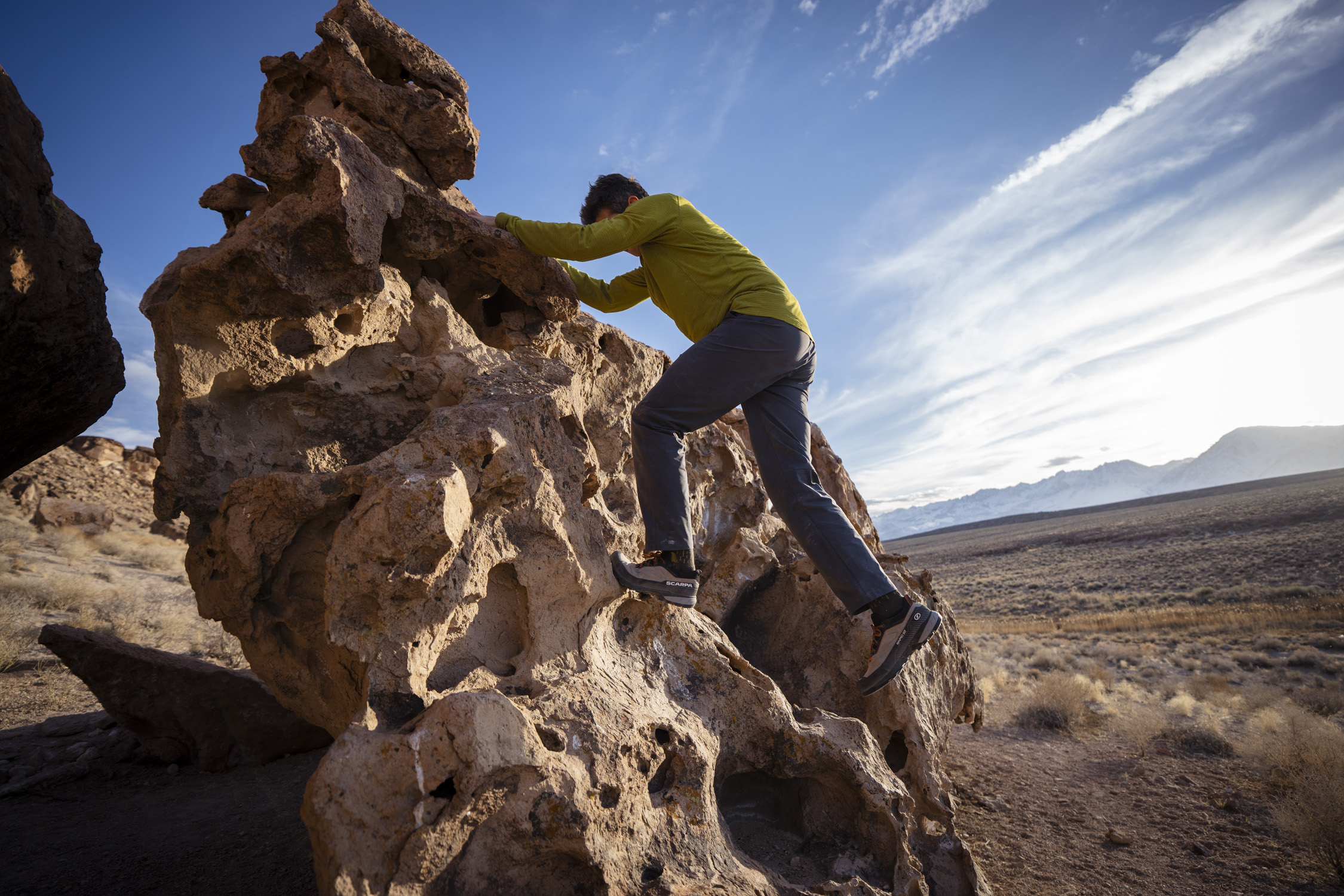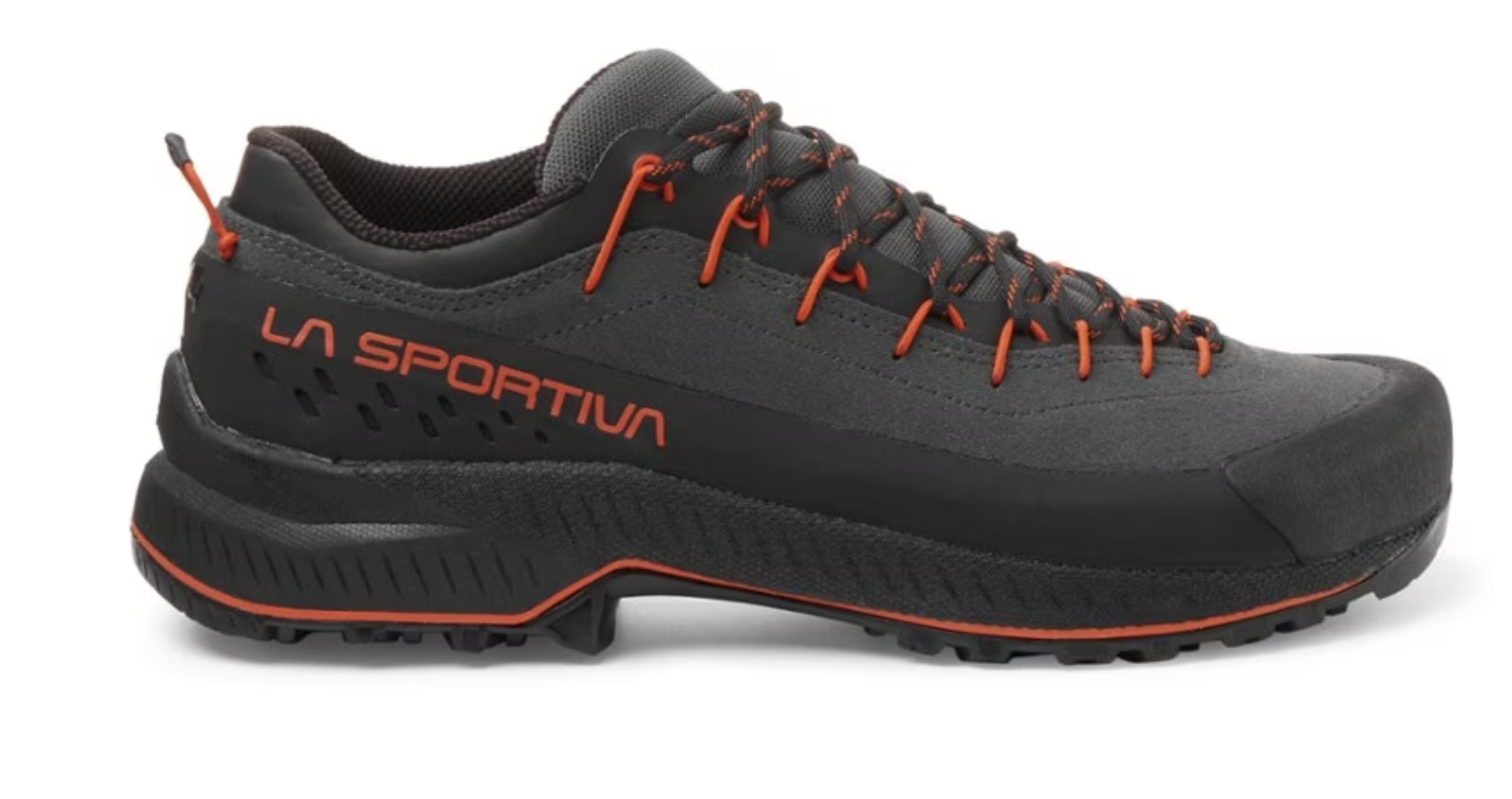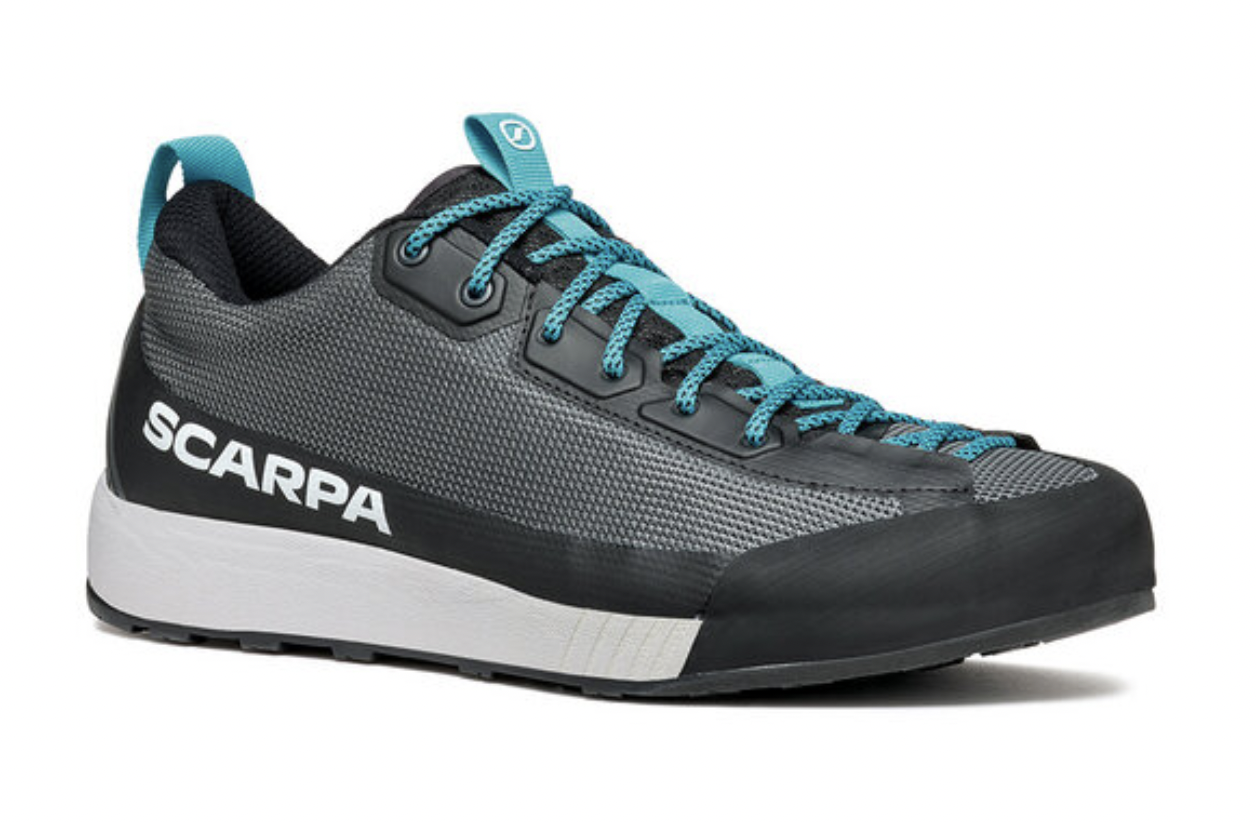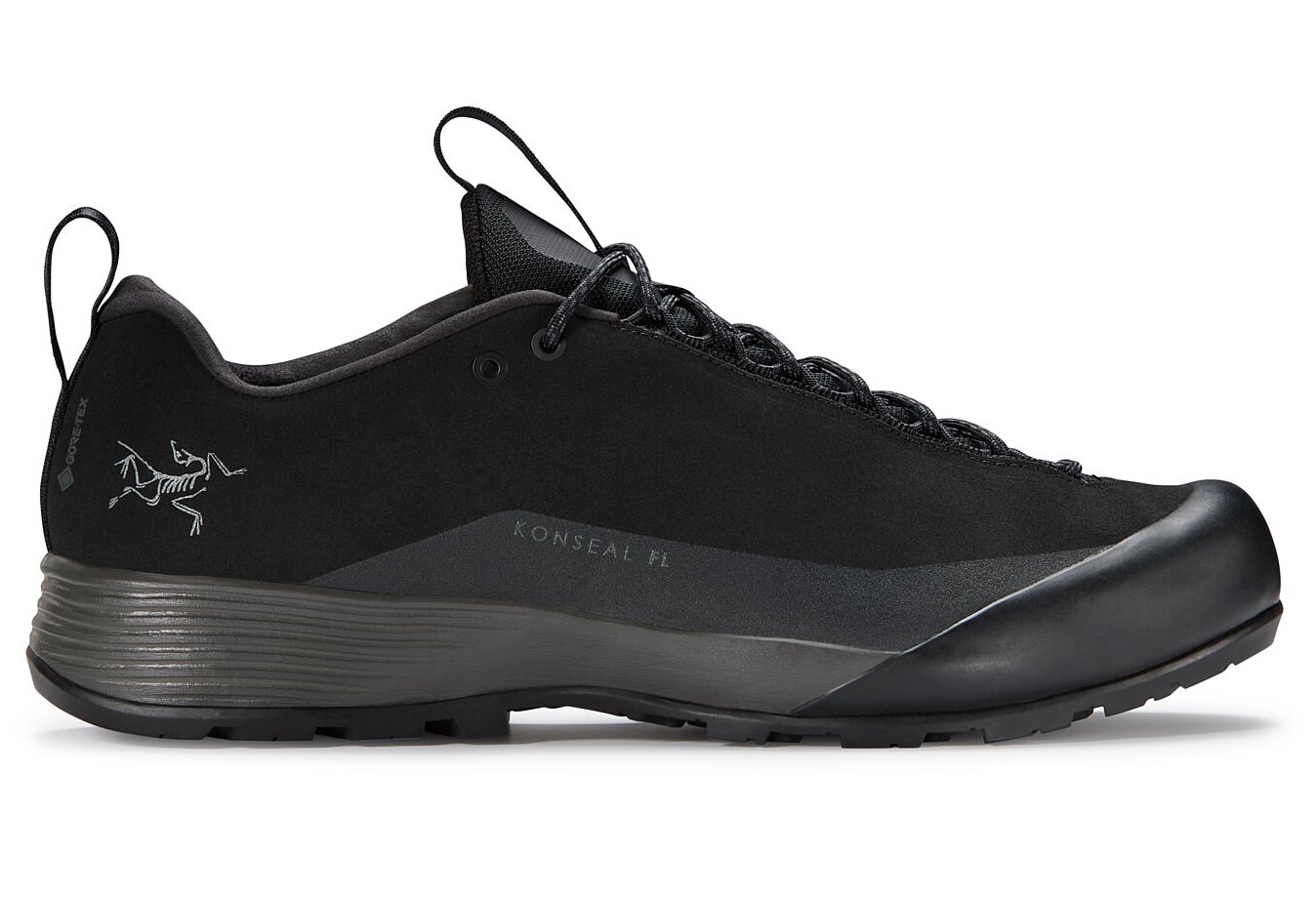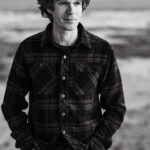From the car to the cliff, a good pair of approach shoes can help you reach your rocky objective in style. Approach shoes combine characteristics of hiking boots and climbing shoes to create versatile footwear that excels in rocky terrain.
To create this roundup, our team of expert gear testers wore dozens of different approach shoe styles and made meticulous notes about the pros and cons of each. Lead author Austin Beck-Doss is based in Lander, Wyo., where steep muddy treks to sport crags and long slogs to alpine routes provide the ideal approach shoe testing ground.
Also contributing is editor Matt Bento. As a former YOSAR member and Bishop, Calif., local, he draws on 20 years of experience, employing approach shoes on technical rescues, aid climbing on the big stone, and High Sierra ridge scrambles.
We’ve organized the best approach shoes on the market into several distinct categories. Whether you need footwear for quick jaunts to the cliff or multi-day slogs through the mountains, our list has you covered.
Editor’s Note: For our March 12, 2025, update, we’ve added the SCARPA Rapid XT, our new overall favorite approach shoes.
The Best Approach Shoes of 2025
Best Approach Shoes for Short Hikes and Hanging Out at the Boulders
Black Diamond Session Suede
6.9/10 RatingSCARPA Rapid XT
- Weight: 1 lb., 8 oz. (men’s size 10)
- Upper: .8mm Suede/Polyester mesh
- Outsole: Vibram® Agility XT / Megagrip
Pros
- Rugged
- Supportive for carrying heavy loads
- Great traction for scrambling
- Stiff platform for standing in aiders/jugging
Cons
- Heavy
- Not as precise for climbing as a thinner soled lightweight shoe
La Sportiva Boulder X
- Weight: 2 lbs., 3 oz. (pair, men’s 10)
- Upper material: Leather
- Outsole: Vibram Megagrip Idro-Grip V Smear
Pros
- Good value
- Durable
- Comfortable
Cons
- Heavy
- Not the best for fifth-class climbing
La Sportiva TX4 EVO
-
Support
9.0
-
Durability
9.2
-
Style
8.5
-
Performance
9.2
- Weight: 1 lb., 10 oz. (men’s size 9.5)
- Upper: Nubuck leather
- Outsole: Vibram Megagrip
Pros
- Roomy in the front
- Very durable
- Supportive for heavy loads or standing in aiders
Cons
- Not very breathable
- Heavy
- Bulky
SCARPA Gecko LT
- Weight: 1 lb., 8 oz. (pair, men’s 9.5)
- Upper: Eco Fabric + Film
- Outsole: PRESA APR-03 / SuperGum
Pros
- Fairly lightweight
- Breathable without sacrificing durability
- Stiff and supportive
- Versatile
Cons
- Run ever so slightly small; be mindful if you have wide feet
Black Diamond Session Suede
- Weight: 1 lb., 5 oz. (pair, men’s 9.5)
- Upper material: Suede leather
- Outsole: Black Diamond Black Label-Street
Pros
- Versatile
- Trendy appearance
Cons
- Not ideal for technical climbing
- Not very supportive
Other Sticky Rubber Approach Shoes We Tested
- Weight: 1 lb., 12 oz. (pair, men's 9.5)
- Upper material: Split-suede leather
- Outsole: Vibram Megagrip
Pros
- Durable
- Capable on technical terrain and cracks
- Waterproof
Cons
- Hot
- Expensive
- Weight: 1 lb., 3 oz.
- Upper material: Spectra mesh
- Outsole: Vibram rubber
Pros
- Breathable
- Lightweight
- Easily adjustable fit
Cons
- Not ideal for foot jamming
- Weight: 1lb. 12.2 oz.
- Upper Material: Suede
- Outsole: Vibram Megagrip
Pros
- Durable
- Sticky
- Well-equipped for technical climbing
Cons
- Not the most breathable
- Expensive
Approach Shoe Comparison Table
| Approach Shoes | Price | Weight | Upper Material | Outsole | Best For |
|---|---|---|---|---|---|
| SCARPA Rapid XT | $169 | 1 lb., 8 oz. (men’s size 10) | 0.8mm Suede/Polyester mesh | Vibram Agility XT / Megagrip | Long approaches and heavy packs |
| La Sportiva Boulder X | $149 | 2 lbs., 3 oz. (pair, men’s 10) | Leather | Vibram Megagrip Idro-Grip V Smear | Long-term durability |
| La Sportiva TX4 EVO | $159 | 1 lb., 8 oz. (pair, men’s 9.5) | Leather | Vibram Megagrip Traverse | Long approaches and all-day scambling |
| Black Diamond Session Suede | $150 | 1 lb., 5 oz. (pair, men’s 9.5) | Suede leather | Black Diamond Black Label-Street | Urban use and mellow approaches |
| The North Face Cragstone Pro | $169 | 1lb., 3 oz. (pair, men’s 10) | Spectra mesh | Vibram Litebase | Light and fast objectives, hot weather |
| SCARPA Gecko LT | $169 | 1 lb., 8 oz. (pair, men’s 9.5) | Eco Fabric + Film | PRESA APR-03 / SuperGum | All around use |
| Arc’teryx Konseal FL 2 Leather GTX | $220 | 1 lb., 12 oz. (pair, men’s 9.5) | Split-suede leather | Vibram Megagrip | Scrambling, aid climbing, foot jamming |
| SCARPA Mescalito | $229 | 1 lb., 12.2 oz. | Suede leather | Vibram Megagrip | Longer approaches with heavy packs |
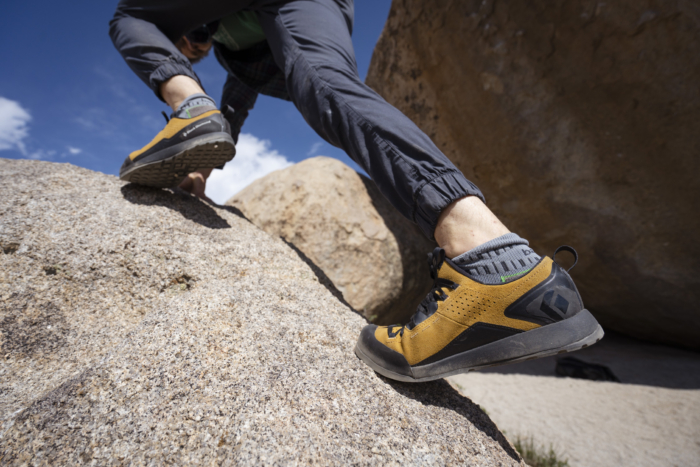
How We Tested the Best Approach Shoes
The GearJunkie team is full of climbers, from weekend dabblers to recovering dirtbags. And, like most modern climbers, approach shoes are a key part of our standard attire. Sticky rubber at the ready, we approach the office, we approach the grocery store, and when we’re lucky, we approach the crag.
In all seriousness, though, we’re actually lucky enough to spend a lot of time approaching climbing objectives both big and small, giving us loads of opportunities to test these sticky rubber ramblers.
Our Expert Testers
Matt Bento is a climber with over 2 decades of experience, including a 4-year stint working for Yosemite Search and Rescue. He still wears approach shoes to do just about everything. His feet are a U.S. men’s 9.5 and a little on the wider side, and he finds that between the major climbing shoe brands, La Sportiva fits him best more often than not, Scarpa occasionally nails it, and Black Diamond shoes are a bit too narrow.
Tester Austin Beck-Doss resides in beautiful Lander, Wyo., and usually prefers the Scarpa fit. We all have our biases, so whenever possible, we’re letting friends with different-shaped feet scramble around in our test models for feedback and alternate opinions.
Our Testing Grounds
Bento lives in Bishop, Calif., arguably the perfect place to test approach shoes. Here, he can scramble the famous Smoke Rock course in the Buttermilks, chimneying, tunneling, and free climbing up to 5.8 while assessing how well these approach shoes handle bullet granite and disintegrating kitty litter.
In the summer, there are plenty of long approaches to be had in the high Sierra, with ridge scrambling across Mt. Emerson and Temple Crag adventures. Yosemite Valley is a short drive away, so we also get to see how it feels to stand in aid ladders and how the shoes hold up to the rigors of jugging fixed lines.
Our Testing Process
In addition to hiking, approach shoes need to hold up to jamming in cracks and grinding against stone while ascending fixed lines. The best approach shoes need to be much more durable than your average hiker, and still provide the support you need for long walks with heavy loads.
Fortunately, our testers have built climbing into their lifestyles, getting out to the crag or into the mountains at least 3 days a week. We cycle through different models, sometimes wearing a different shoe on each foot for comparison.
As far as standardized testing is concerned, Matt Bento likes to solo the Northwest Books on Lembert Dome in each pair of approach shoes. This route is only 5.6, but involves some smearing, edging, and a little bit of crack climbing, plus a slabby walk-off. A good fit is key to feeling confident while unroped on this terrain, and if the sole rubber doesn’t feel particularly sticky, he’ll bail onto an easier variation.
For hiking, we’ll put in an average of 8-10 miles in every shoe while carrying the typical climbing load — rope, rack, shoes, harness, food, and water. Here, we pay attention to any hot spots, how well the laces stay tied and lock the foot in place, water resistance, and overall comfort.
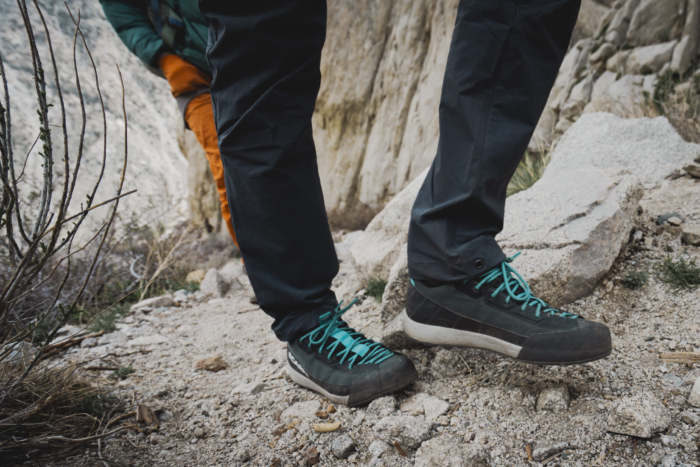
Buyer’s Guide: How to Choose Approach Shoes
What Are Approach Shoes?

Approach shoes are a cross between hiking shoes and climbing shoes. They combine the best traits of both parent categories to maximize performance between the car and the crag.
Though our list of recommendations includes a broad spectrum of features, approach shoes generally have a few key characteristics. Most importantly, they have a sticky rubber outsole. To earn a place in the “approach” category, a pair of shoes must have some capacity to stick to rock and execute relatively technical movements.
Many approach shoes come with a built-in “climbing zone” — which is a patch of smooth rubber near the toe that can be used to smear and stand on small footholds. Accessing the base of climbing routes often requires fourth or low-fifth-class climbing — this is where approach shoes shine.
Along with durable sticky rubber soles, approach shoes should also have a durable upper and offer some baseline stability. From long slogs on the trail to boulder hopping up talus, approach shoes must put up with serious wear without falling apart. If they’re too flimsy or thin, they probably can’t withstand the abuse that a true approach shoe should. Ultralight trail runners and legitimate approach shoes are not the same.
While hiking shoes tend to have a curved, rocker profile, technical approach shoes usually have a flat sole. A flat sole makes it easier to channel power into your toes and stand on small footholds.
All of the shoes on this list are proper approach shoes. Some are light and nimble, others are super supportive and robust, but they’re all built to meet the needs of climbers on a mission.
Climbing Ability and Outsole
By design, approach shoes are far more suited for technical climbing than hiking shoes. For the most part, the superior grip and climbing ability come from a soft and sticky rubber outsole. As climbers know, super soft, tacky rubber is the ideal material for climbing rock with confidence.
Approach shoes have hybrid outsoles that combine climbing shoe and hiking boot features for maximum versatility. Approach shoe rubber is relatively soft, but it should still maintain traction on the trail.

When shopping for climbing shoes, it is important to consider where and how you will use them. If you plan to wear your approach shoes while scrambling on steep terrain and climbing 4th- and 5th-class rock, be sure to choose a shoe with soft rubber and an ample climbing zone. If you’ll mostly be hiking on low-angle trails, general performance and comfort should be greater priorities than technical climbing features.
If you are a well-rounded mountain goer, we recommend approach shoes with a customizable fit that you can adjust according to the activity at hand. For maximum customization, look for a lacing system that runs the length of the upper and all the way down to the toe.
Upper Material: Synthetic or Leather?
On this list, the La Sportiva TX4 EVO is an approach shoe with ultra-impressive technical climbing ability. For moderate terrain and casual multi-pitch days, the Black Diamond Session is a good comfort-forward option. The excellent Scarpa Gecko LT is a good compromise between both styles.
A shoe’s upper is the material that makes up the top of the shoe. In the approach shoe category, most uppers are made from either leather or synthetic material. Both options have their pros and cons, and neither is strictly better than the other.
Leather uppers, similar to those found on traditional hiking footwear, offer supreme durability. We’ve long-term tested both leather and synthetic approach shoes, and the leather styles seem to hold up to more rugged use.
Leather also has an advantage when it comes to water resistance. It naturally repels water and doesn’t fully rely on a Durable Water Repellent (DWR) treatment to keep your feet dry.
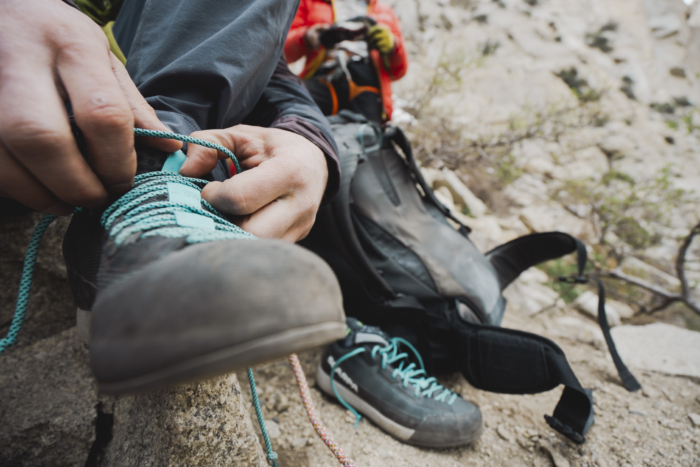
In warm conditions, leather does not breathe especially well and can cause uncomfortable, hot feet. If you plan to wear your approach shoes for desert climbing in places like Joshua Tree or Red Rock, leather may not be the ideal choice.
Leather also stretches, while synthetic does not. If you purchase leather approach shoes, it is important to realize that they will become a bit roomier over time.
On this list, the SCARPA Rapid XT and the La Sportiva TX4 EVO have durable and water-resistant leather uppers, whereas the very capable Scarpa Gecko LT has a lightweight and thoroughly breathable synthetic upper.
Durability
Approach shoes are meant to be worn in rugged and rocky terrain, and long-term durability is a must. In our experience, the upper materials on approach shoes wear out long before the rubber outsoles do.
As the outsole wears, the tread becomes smooth and shallow, but the shoes can typically go on functioning without issue. Plus, many approach shoes can be resoled. When the upper falls apart, however, the shoes no longer function as needed.
When climbing on rock or standing in aid ladders, the toe-end of approach shoes take a lot of abuse. Most shoes on this list have a sticky rubber rand that wraps up and over the toe, which adds durability in a key area — just about all of the longest-lasting styles have it.

If durability is a priority for you, we recommend a pair of heavy-duty approach shoes with a rubber toe rand and a leather upper. Leather does get warm in summer conditions, but it also tends to last longer than synthetic material. On this list, the La Sportiva Boulder X is an impressively durable and long-lasting approach shoe.
Support and Stiffness
Climbing gear is heavy, and hauling a fully loaded backpack calls for supportive footwear. Backpackers tend to wear stiff and supportive boots for stability, and in many ways, climbers have similar needs.
Additionally, stiff shoes tend to work better for standing on small edges and climbing cracks. Aid climbers also tend to prefer stiff shoes — standing in slings is downright painful in floppy shoes. On this list, the SCARPA Rapid XT is on the very stiff end of the approach shoe spectrum.

Not all approach shoes are stiff and supportive. While super stiff shoes may be nice while hiking with a full rack and a rope, they have some downsides.
Firstly, stiff shoes sacrifice agility and flex, which can come in handy while scampering up a talus field or soloing an easy approach pitch. If you’re looking for a soft and nimble approach shoe, check out the Black Diamond Session Suede.
Style
Approach shoes are built for the outdoors, but many climbers choose to rock them as their go-to, do-it-all footwear. While aesthetics aren’t the main purpose of approach shoes, some recent styles have become quite spiffy.

On this list, shoes like the Black Diamond Session Suede have a lightweight profile and modern styling that looks great in the climbing gym and other front-country settings.
Weight and Packability
When multi-pitch climbing, it is common to clip a pair of approach shoes to your harness to wear while rappelling or hiking back to the base of the route. For this reason, we love it when approach shoes are light and packable.
Light shoes come in handy, but it’s important to maintain a balance between total weight, performance, and durability. Super light approach shoes like The North Face Cragstone Pro are not the most stable or long-lasting. Burly and stiff shoes like the La Sportiva Boulder X can foot jam beautifully, but they take up lots of space on a harness.
If you’re looking for a good middle ground, the SCARPA Gecko LT is light and fairly supportive. On the other hand, if you’re looking for something that you can just clip to your haul loop and forget about, the Session Suede weighs just over 1 pound per pair. Plus, the heel collapses down so they’ll take up less space on your harness.
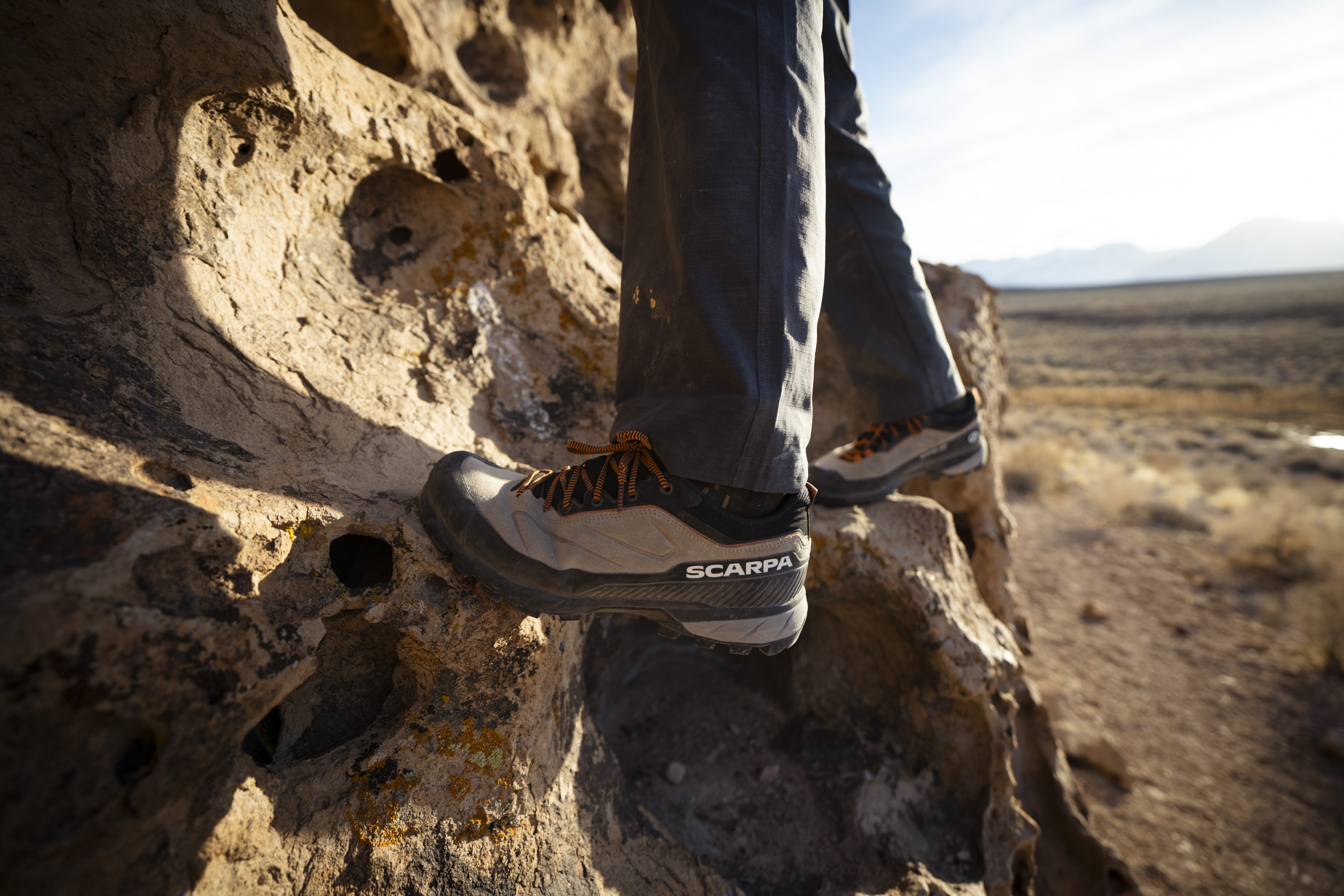
Price & Value
There isn’t a huge variation in price among the approach shoes in our selection. We don’t currently cover any high-top models. You can expect a higher price for these as they use more material. Shoes with a GORE-TEX liner won’t be cheap, as getting the Gore stamp of approval along with the liner itself always increases the price. Certain brands also command a high price, but as you’ll see, paying more doesn’t necessarily get you a better pair of approach shoes.
Budget
A good, usable pair of approach shoes will run you around $150. Our budget pick is the La Sportiva Boulder X ($150). These trusty shoes have been around for a long time and have seen little change in their overall design. They work great for hiking and scrambling, though their all-leather upper isn’t very breathable, so they aren’t the most comfy in hotter conditions.
We’ve also experienced some delamination at the toe after jugging lines and aid climbing, but if you don’t aid climb, you won’t have much to worry about with the Boulder X in terms of durability. They also scream, “I am a rock climber,” which you may want to consider when out on the town.
Mid-Tier
Mid-tier may sound like “meh” but the middle of the price range actually includes the best approach shoes out there, our favorites being the SCARPA Rapid XT ($169) and the La Sportiva TX4 Evo ($159). The TX4 is a better hiker than the Boulder X and scrambles just as well, while only costing about $10 more. The Gecko LT ($169) is a nice alternative from Scarpa if you’re looking for a shoe that looks a little more “normal” for around town but still scrambles and hikes well.
Premium
Above $200 and you get the premium models. The Arc’teryx Konseal FL 2 GTX ($220) is a low-top shoe that scrambles well and is completely waterproof. Is it $60 better than our top pick? That’s arguable. If a waterproof-breathable membrane is helpful for where you like to climb (probably the Southeast) then the extra cash may be worth it.
But know that both the Konseal and the TX4 have similar attributes when it comes to scrambling, both are high-quality, and if you’re never out in the rain, save yourself some money. Finally, the Scarpa Mescalito ($218) sits down at the end of our list, but by no means should it be overlooked. It’s a burly, all-synthetic shoe with 45% recycled uppers, and holds up just as well as the all-leather competition.
Frequently Asked Questions
Hiking and approach shoes are similar, but there are a handful of key characteristics that differentiate the two categories. While hiking shoes are designed for waking on relatively flat surfaces, approach shoes are made to venture into rocky and technical terrain.
In general, approach shoes have a flat sole with a soft and sticky rubber outsole that is similar to a climbing shoe. The soft rubber conforms to rock and provides lots of friction when smearing or edging. Hiking shoes tend to have a rockered profile and a harder rubber compound that prioritizes durability and works well on dirt and mud.
Approach shoes have semi-shallow tread patterns that are far less aggressive than the deep lugs of most hiking shoes. While climbing or scrambling over rock, shallow tread maximizes surface contact and increases friction.
Many approach shoes have a “climbing zone,” which is a completely flat plane of sticky rubber underneath the toe. This feature is great for climbing rock, but it can also be a detriment while hiking through mud or sand.
Ultimately, there is a lot of overlap between hiking and approach shoes. In many cases, you could use hiking shoes as approach shoes and vice versa.
The shoes don’t make the climber. The climbing ability of any shoe depends on the skillset and comfort level of the user. With that said, all of the approach shoes on this list are designed to handle technical, rocky terrain. Some, however, are far more capable than others.
Of the numerous shoes that we tested, the La Sportiva TX4 has the most impressive climbing ability.
If you’re looking for great value without sacrificing technical ability, check out the La Sportiva Boulder X.

The Best Climbing Shoes of 2025
Aside from the ice climbers, mountaineers, and Charles Albert, every climber needs a pair of reliable climbing shoes.

The Best Men’s Climbing Pants of 2025
Our climbing fanatic found the best climbing pants of 2024. Whether heading to the gym or hitting up your local crag, we’ve got you covered.
